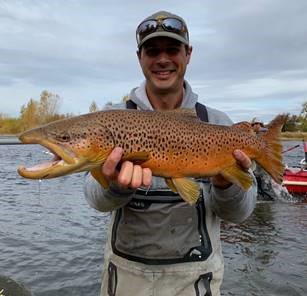Henry’s Fork, February 25th, 2022
Excerpts from Dr. Rob Van Kirk’s February 24th Henry’s Fork water supply report are below.
Headlines:
- A very dry week dropped water-year precipitation to 92% of average and SWE to 77% of average.
- Since Wednesday’s reduction in outflow, Island Park Reservoir fill rate has averaged 233 ac-ft/day, up from 150-190 ac-ft/day for most of the last five weeks.
- Weather forecasts have been highly variable from day to day over the past week but are certain of widespread snowfall tonight and tomorrow and chances of precipitation over the next week.
Details:
Mean temperature last week was 2 degrees F above average, and yesterday’s watershed-average maximum temperature of 39 degrees was the warmest since December 4. Last week was as dry as any in the current dry spell, now in its sixth week. Precipitation was recorded at only four of the 12 stations, amounting to only a few hundredths of one inch when averaged across the watershed. This dropped water-year precipitation from 96% of average last week to 92% of average this morning. In the bigger picture, the three-year running average precipitation, which is a good measure of overall drought conditions at a scale relevant for ecological process and long-term water supply, dropped from just a fraction of an inch below average in early January to 2.5 inches below average over the past five weeks.
The figures for snow water equivalent (SWE) are even worse. Net accumulation of new SWE over the week was 0, dropping SWE from 81% of average to 77% of average over the week. If we have average SWE accumulation between now and early April, this year’s snowpack will end up around 20% below average. At best, we could barely hit average if the remainder of the winter is extremely wet. In the 1989-2021 record, only two years—2011 and 1989—were wet enough between February 14 and April 8 to push this year’s snowpack up to average. That’s only two observed scenarios in the past 33 years, giving us roughly a 6% chance of getting to average in the modern climatic regime.
Weather forecasts and climate outlooks at all scales have not only performed poorly over the past month but have become highly variable from day to day over the past week. Forecasts for this week went from wet a week ago to dry by the end of last week to wet again this morning. Widespread precipitation is expected tonight and tomorrow, followed by moderate chances over the remainder of the week. More widespread precipitation is expected again next weekend. The current 7-day quantitative precipitation forecast is the best it has looked in over a month, calling for widespread amounts of 0.25 inch in the valleys to over 1 inch along the Wyoming border. However, confidence is low past Wednesday of this week. Nonetheless, we will see at least some change from persistent high pressure.
Since Wednesday’s 20-cfs reduction in outflow from Island Park Reservoir, fill rate has averaged 233 ac-ft/day, up from 150-190 ac-ft/day over most of the past five weeks. The reservoir is 82% full, compared with 76% on average. If precipitation over the next week materializes as predicted, gain will be enhanced by about 50 ac-ft/day due to direct precipitation. Outflow has averaged 217 cfs since December 1.
Rob Van Kirk, Ph.D.
Senior Scientist
P.O. Box 550
Ashton, ID 83420
208-652-3567 OFFICE
208-881-3407 CELL
208-652-3568 FAX

